Perceptual Positions - Part 1
Gabriel R. Suciu, Romania
Menu
Introduction
Illustrations
Forerunners
Conclusion for Part (1)
References
We live in a world with multiple dimensions. In algebra this could be expressed by formulas involving “n” – even “n + 1” – dimensions, so by an (or many more..?) infinite dimensions, and still long before the time of Descartes.
However, these formulas could not be of much help because, until now, in geometry no one could operate with more than three dimensions – width, length and height – and, in physics, Einstein proposed four dimensions to understand the universe – the so-called concept of “space-time” – while later physicists were satisfied with ten dimensions – the theory of “super-strings” being one of the newest in explaining the universe.
The existence of a universe with multiple dimensions is more archaic in nomothetic sciences (like literature) than in ideographic sciences (like mathematics or physics). For instance, in any language the natives use more or less the personal pronouns – such as “I”, “you”, “he”, “she” and so on – the “perceptual positions” in contemporary psychology being stated starting from them. Although it remained for the generations of psychologists to come to talk about perceptual positions derived from plural pronouns – especially from second and third ones, or from personal pronouns indicating things and objects.
So, who could say that one of these sciences – whether ideographic or nomothetic – can be a model or template for the other one, since either maturity or completeness can be found, inside each of them, to lack …?
There are phenomena that would seem rather magical than real without the presupposition that “the universe has multiple dimensions”. Here are two examples:
Example 1
A woman is looking in the mirror. Thus two women appear identical: the real woman and the woman in the mirror. However: a) why the left hand of the real woman is the right hand of the woman in the mirror? And: b) why the image in the mirror is reversed only left-right, and not top-down, so the head of the woman in the mirror is not upside down, but head up, like the head of the real woman?

The answer to these two questions is… the universe has multiple dimensions. The real woman has three dimensions (width, length and height), while the woman in the mirror has two dimensions (width and length). Therefore left-right reversal is possible because the two women have two dimensions that match – width and length. (Remember, they are sitting face-to-face). But top-down reversal is not possible because the woman in the mirror is missing the third dimension – namely, height.
Example 2
A point rotates in a circle, constantly. Behind the circle is a wall. On the wall, the shadow of the point moves on a line, accelerating to extremities, but slowing down to the center. Why is circular and constant the movement of the point, while the same movement is linear and fluctuating for its shadow?
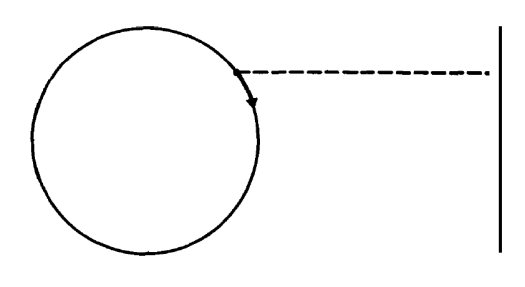
The answer to this question is, again... the universe has multiple dimensions. The point that is moving in a circle is moving in two dimensions, namely length and width. However, its shadow is moving on a line that has only one dimension, namely length. So the same move in two dimensions appears to be constant, but in one dimension is fluctuating.
Along with these two examples, below I will present three illustrations – two metaphors and a concept – that are validating the presupposition that the universe has multiple dimensions. After presenting these three illustrations, I’ll restrain the area of my research to the concept, present in the contemporary psychology, of “perceptual positions”…
Triangulation
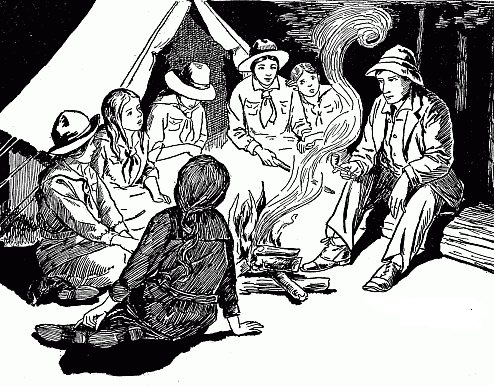
The term ‘triangulation’ appeared in geometry and trigonometry and has been used since Antiquity to measure the height of pyramids, or to estimate the distance of a ship towards the shore. Later, it was borrowed by the social sciences to achieve a unified truth using multiple observers. Underlying this practice stood the belief that truth is always in the middle, and that, all around it, observing it, are the social actors with their different perspectives. Just like the fire that gathers around it, at midnight, the people. Only through open communication and by sharing these multiple and subjective opinions, the whole and objective truth can be achieved, because no person, in particular, is the ultimate truth holder, while mankind, as a whole, is.
The drama in the “Rashômon” (1950) film is woven around the concept of “triangulation”. Rashômo was the former city gate between Kyoto and Naro. While sheltering under this gate, a commoner wanted to hear the story that was horrifying a priest and confounding a woodcutter. So, the two told him about a murder trial in court, where they have participated as witnesses. The woodcutter has discovered the body of a samurai while he was walking in the woods and called the police. To his turn, the priest has certified that he had met the samurai and his wife while they were heading to the forest. Soon the police caught Tajomaru – a bandit with a reputation for murder and lust – who presented the first version of the facts. Later, before the court, appeared the samurai’s wife who introduced the second version of the facts. Finally, in the end, the judge heard the third version of the facts presented by the samurai with the help of a medium. The three versions claimed the same thing: Tajomaru lured the samurai and tied him with a rope to a tree in order to possess his wife. However the three versions differed afterwards: the bandit said he killed the samurai, his wife said she killed the samurai, while the medium acknowledged the samurai committed suicide. And there, under the old, former city gate, Rashômo, the commoner discovered that there is also a fourth version: in fact, the woodcutter has lied in court out of fear, being witness to what has happened in the woods. According to this second version of the woodcutter, the samurai and the bandit struggled to punish the samurai’s wife who has antagonized them… and from this struggled the bandit came out victorious.
The blind men and the elephant.
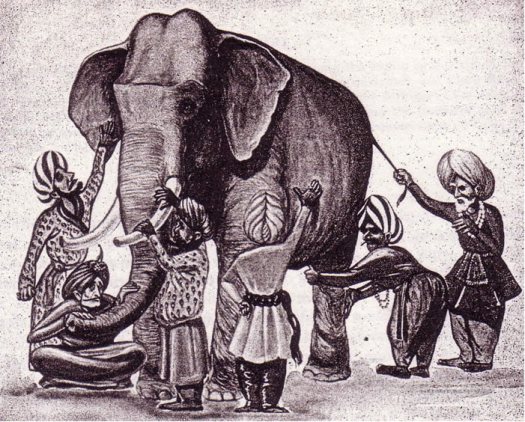
Since ancient times there is a story in which an elephant is found by six blind men (or, by other versions, by six people in the dark). Each of these men comes into contact with only one side of the elephant. Although each has right about his small part explored, they are wrong – first because they do not understand that a whole has different parts – and then because they do not understand that the whole is more than the sum of its parts. This story is told in several Eastern religions – such as Buddhism or Hinduism – and also by the top scientists in the West – such as quantum physicists.
Gus Van Sant was inspired by the story of the six blind men and the elephant to direct the film “Elephant” (2003). The film presents some hours in the lives of some average teenage high school students from different perspectives: Elias – a photography student building his portfolio; Nathan and Carrie – a popular football player and his girlfriend; Brittany, Jordan and Nicole – three bulimic girls who talk incessantly; John – a teenage who has trouble at school; Alicia – a close friend of John; Michell – a nerdy girl ashamed of her body; Benny – an athletic student… and Alex and Eric – the authors of a massacre in their own school. For those hours in the lives of these teenage high school students appear to be the reconstruction of the massacre of Columbine High School happened in 2003.
The melting pot

The ‘melting pot’ is a metaphor of the American society, a metaphor which refers to the assimilation of immigrants of different nationalities in a single whole, assimilation that is also preserving their cultural specificity. This expression was entrenched by Israel Zangwill’s play with the same title, “The Melting Pot”, a remake of William Shakespeare’s play “Romeo and Juliet” – both plays tell the love of two heroes with different background… only one play ends with their death, while the other play ends with the beginning of their life together. In closing, the melting pot metaphor has some equivalent expressions: the mosaic culture, the salad bowl culture, or the kaleidoscope culture.
The “Crash” (2004) film can be viewed trough the googles of the melting pot metaphor, because it shows the clash of different cultures in our days America. The life of several people belonging to different races (the African, the Hispanic, the Persian, the Chinese and the Caucasian) could be traced along two days. First, belonging to the Africans is a police detective, whose brother is a car thief, and whose mother is a hardcore drug consumer. Belonging to the same race is a Hollywood director and his wife. Secondly, both the partner of the black police detective, and a locksmith who moved with his family – his wife and daughter – in a select neighborhood are Hispanics. Thirdly, a family composed of mother, father and daughter, owners of a shop on the corner belong to the Persian race. Fourthly, the Chinese race is represented by a couple that is trading with human beings. Finally, the Caucasians are represented by two policemen, patrol partners; and by the district attorney and his wife.
Next, I’ll speak only about the “perceptual positions” – a central concept to the Neuro Linguistic Programming. My goal is to present how the forerunners of NLP field understood the perceptual positions, and only after that to present how the founders of NLP understand them…
The NLP founders had as models some forerunners like: Gregory Bateson, Paul Watzlawick, Virginia Satir, Milton Erickson and Fritz Perls. Two of these forerunners – namely Bateson and Watzlawick – were more concerned about the “epistemological” (knowledge) side of the perceptual positions, while the other three – obviously, Satir, Erickson and Perls - used the concept in “therapy” (in healing various disorders)…
Gregory Bateson – “double description”
Bateson presented nine cases of double description in his book “Mind and Nature” (1979: 65-88). Of these nine cases, I’ll present here only two – “the case of binocular vision” and “the case of beats and moiré phenomena”. Starting from the concept of “double description”, the founders of NLP developed, later, “the first perceptual position” and “the second perceptual position” – as two patterns that are interacting; and “the meta position” – as the resulting pattern, the pattern found on a higher level.
1. The case of binocular vision
“The binocular image, which appears to be undivided, is in fact a complex synthesis of information from the left front in the right brain, and a corresponding synthesis of material from the right front in the left brain. Later these two synthesized aggregates of information are themselves synthesized into a single subjective picture from which all traces of the vertical boundary have disappeared” (p. 69)
“From this elaborate arrangement, two sorts of advantage accrue. The seer is able to improve resolution at edges and contrasts; and better able to read when the print is small or the illumination poor. More important, information about depth is created.” (pp. 69-70)
This case explains the well known phenomenon that if someone is looking with only one eye s/he is seeing a two-dimensional image, and if the same person is looking with two eyes s/he is seeing an image with three dimensions. Below, the reader could find a sketch with the information route from the two eyes to the brain, the latter being responsible for the synthesis of the two different images received from the eyes.
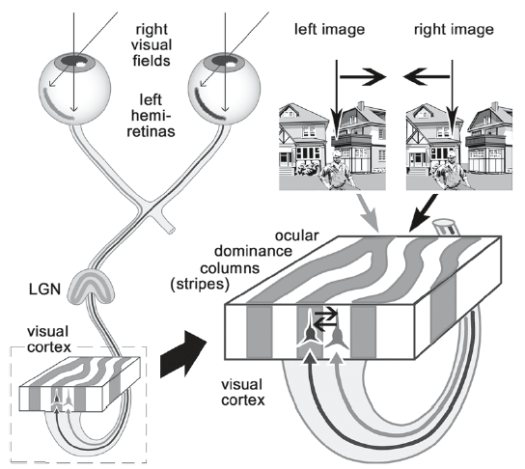
2. The case of beats and moiré phenomena
“The simplest case of what I am calling the moiré phenomenon is the well-known production of beats when two sounds of different frequency are combined. (…) The matter becomes more complex when the rhythmic patterns, instead of being limited, as frequency is, to the single dimension of time, exist in two or more dimensions” (pp. 79-80)
“Three principles are illustrated by these moiré phenomena: First, any two patterns may, if appropriately combined, generate a third. Second, any two of these three patterns could serve as base for a description of the third. Third, the whole problem of defining what is meant by the word pattern can be approached through these phenomena.” (p. 80)
Bateson presented the moiré phenomenon in simple situations – such as the combination of two sounds; and in complex situations – such as the combination of two images. This phenomenon is well known today, so I’ll no longer linger on it, although I’ll add a graphic illustration …

Paul Watzlawick – “dimensions”
Watzlawick, in his book "How Real is Real?" (1960) outlined very briefly the “Flatland” (2002), another book written by Edwin Abbot. The four kingdoms - Pointland, Lineland, Flatland and Spaceland – presented in this book, without considering the other kingdoms which were speculated several times, are nothing more than what NLP insiders are calling “meta-positions”.
“In One Dimension, did not a moving Point produce a Line with two terminal points?
In Two Dimensions, did not a moving Line produce a Square with four terminal points?
In Three Dimension, did not a moving Square produce – did not this eye of mine behold it – that blessed Being, a Cube, with eight terminal points? (…)
Behold the infallible confirmation of the Series, 2, 4, 8…: is not this a Geometrical Progression?” (p. 170)
“Again, was I not taught by my Lord that as in a Line there are two bounding Points, and in a Square there are four bounding Lines, so in a Cube there must be six bounding Squares? Behold once more the confirming Series, 2, 4, 6: is not this an Arithmetical Progression?” (p. 171)
Therefore, the “Pointland” kingdom is inhabited by only one point: that kingdom has 0 dimensions, 0 faces and only 1 vertex. The other kingdoms, however, have a king and many subjects. The “Lineland” has one dimension, two faces and two vertices; the “Flatland” has 2 dimensions, 4 faces and 4 vertices; and, finally, the “Spaceland” has 3 dimensions, 6 faces and 8 vertices. Therefore:
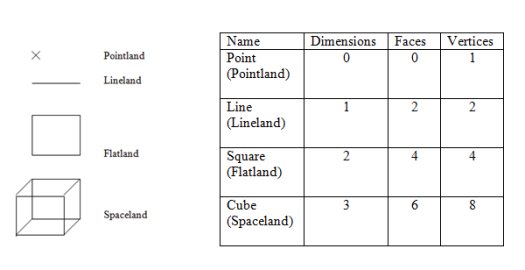
Virginia Satir – “stances”
Although the vision of Virginia Satir was illustrated in several of her books (such as “Changing with Families” [1976] and “The New Peoplemaking” [1988]) below I’ll refer only to the book “The Satir Model” (1991). In this book she presented five categories: placating, blaming, being super-reasonable, being irrelevant and leveling. Based on these five categories the NLP field later formulated the three perceptual positions: the “first position” (or the ego), the “second position” (or the alter ego), and the “third position” (or the observer).
“Placating is one of the four major ways we respond when we feel our survival is threatened. When we placate, we disregard our own feelings of worth, hand our power to someone else, and say yes to everything. (…) The person who placates honors the other person and the context of their interaction but does not honor his or her own true feelings.” (p. 36)
“Blaming is diametrically opposed to placating. The blaming stance is an incongruent way of reflecting society’s rule that we should stand up for ourselves and not accept excuses, inconvenience, or abuse from anyone (…) To protect ourselves, we harass and accuse other people or circumstances. To blame is to discount others, counting only the self and the context.” (p. 41)
“The super-reasonable pattern of communication discounts the self or the other person. Being overtly reasonable means functioning with respect to context only, most frequently at the level of data and logic.” (p. 45)
“The fourth survival stance is being irrelevant, commonly confused with being amusing or clownish. The irrelevant pattern is the antithesis of the super-reasonable one. It makes super-reasonable people appear silent and stable by contrast. (…) The self, the other person, and the context of their interaction do not matter to such people when they are being irrelevant.” (pp. 48-49)
The leveler is not an incongruent, but a congruent person that is functioning with respect to self, other and context.
In the same book, Satir described those five categories according to several axes, such as: words, affect, behavior, inner experience, psychological effects, and physiological effects. It’s needless to say that each of the five categories can be observed having a specific nonverbal communication.

Milton Erickson – “perceptual positions”
Sidney Rosen – in his book “My Voice Will Go with You” (1982) – presented a hypnosis session with Milton Erickson where were used the three perceptual positions (the first position/ the self, the second position/ the other, and the third position/ the observer) and the meta-position, the latter being called “the middle of nowhere”. The expression is paradoxical because there is not such a thing as nowhere and, more than that, this nowhere can’t have a middle, or does it?
“I had a girl over for a demonstration of deep trance and trance phenomena for Dr. Ernest Rossi. I told her to go into a deep trance and to meet me in the middle of nowhere. She promptly opened her eyes, in the trance state, and said, very earnestly,
Dr. Rossi did not know what was wrong – but she knew what was wrong. Now, what’s wrong about meeting me in the middle of nowhere?
There is no middle of nowhere! It’s vacant space.
I had her close her eyes and I awakened her from the trance, and then I said, I want you to do another task for me. I want you to meet me in outer space after going into a trance>.
She opened her eyes in a trance state. It was obvious that she was not oriented to the room, the floor, or anything. Then I told her, .
What did she do? She said, .
The hypnotic subject listens very literally.” (pp. 75-76)
In few words, without maps or other visual devices, Milton Erickson presented a broader perspective than the other forerunners. Although it is much said “presented” because, starting from his words, the readers have an intuition about the perceptual positions. Moreover, Milton didn’t entitle himself the discoverer of these perceptual positions. In fact, the discoverers were… his own clients.
Fritz Perls – “empty chair (two chairs)”
Fritz Perls wrote about the technique “the empty chair” (also known as “the two chairs”) in such books as “Gestalt Therapy” (1951) or “Gestalt Therapy Verbatim” (1992). But this technique will be presented in a more accessible manner by a later Gestalt psychologist – Leslie Greenberg (especially in two articles – one called “Resolving Splits” [1979], and the other “Toward the Task Analysis of Conflict Resolution in Gestalt Therapy” [1983]). The two chairs are “the experiencing chair” and “the other chair” (or in the terminology used by Perls: “the under-dog” and “the top-dog”), representing the two sides of any split. Considering these two parts (these two chairs), the later psychologists have written extensively about the three perceptual positions: the self, the other, and the context.
“Perls (1969) has popularized the notion of Top Dog and Under Dog and shown how the bullying authoritarian part of the personality engages in an endless dialogue with the manipulative excusing part of the personality (…) Research and observation of the process of the two chair dialogue has shown that the two chairs in the dialogue can be profitably characterized as the and the (Greenberg, 1976; Greenberg, in press). These chairs have similarities to Under Dog and Top Dog respectively, but can be used to describe the unfolding of the dialogue in productive therapeutic process as the person moves to resolution” (1979: 319)
“The three stages of conflict resolution proposed in the model are opposition, merging, and integration. The first stage is characterized by a relationship of opposition between the two parts in conflict. One aspect of the personality, labeled as the , is critical, hostile, intimidating or threatening toward another part, labeled the , which is initially rebellious, passively compliant, helpless or avoiding. These are the characters of the self-manipulation struggle which Perls (1970) called and . (…) During [the] second or phase both sides of the conflict are clearly stated, with feeling, each part experiences a greater sense of internal locus of control and the relationship between the parts becomes more affiliative. (…) Finally, in the integration phase of the dialogue, a negotiation or integration takes place between the sides in which they mutually listen, understand and accept each other, to form a resolution in which opposing aspects of the conflict are reconciled (Johnson, 1980).” (1983: 191)
Therefore, any conflict has three stages: opposition, merging and integration. In the first stage (the opposition stage) are outlined two parts – one which is necessarily the self, while the second could be: the self, the other or the context. In the second phase (the merging stage) each of the two sides is wearing the moccasins of the other side. Finally, in the third stage (the integration stage) the two sides behave as one part – they become a whole.

There is an old story about a tribe located on the edge of a volcano. One day the volcano became active. And the tribesmen, considering that their God, the Volcano, was angry with them, began to sacrifice all kinds of animals: chickens, lambs, pigs, and so on. But the Volcano was becoming more and more threatening. And the tribesmen were becoming more and more agitated because they were thinking not knowing the correct sacrifice to pacify their God. And just in those moments, the seven days psychologist appeared bringing them relief. He taught them various change techniques including perceptual positions. And so tribesmen calmed down and became again happy.
In the next days, the volcano erupted...
Crash (2004): http://www.imdb.com/
Elephant (2003): http://www.imdb.com/
Rashômon (1950): http://www.imdb.com/
Abott, Edwin (2002): “The Annotated Flatland. A Romance of Many Dimensions”, Basic Books
Bateson, Gregory (1979): “Mind and Nature”, E.P. Dutton
Bandler, Richard; John Grinder & Virginia Satir (1976): “Changing with Families”, Science and Behavior Books, Inc.
Greenberg, Leslie (1979): “Resolving Splits”, Psychotherapy: Theory, Research and Practice, vol. 16, no. 3, pp. 316-324
Greenberg, Leslie (1983): “Toward a Task Analysis of Conflict Resolution in Gestalt Therapy”, Psychotherapy: Theory, Research and Practice, vol. 20, no. 2, pp. 190-201
Perls, Frederick; Ralph Franklin Hefferline & Paul Goodman (1951): “Gestalt Therapy”, Julian Press
Perls, Frederick (1992): “Gestalt Therapy Verbatim”, Gestalt Journal Press
Rosen, Sidney (1982): “My Voice Will Go with You”, W.W. Norton & Company
Satir, Virginia (1988): “The New Peoplemaking”, Science and Behavior Books, Inc.
Satir, Virginia; John Banmen, Jane Gerber & Maria Gomori (1991): “The Satir Model”, Science and Behavior Books, Inc.
Watzlawick, Paul (1960): “How Real is Real”, Twayne Publishers, Inc.

Please check the NLP & Coaching course at Pilgrims website.


|